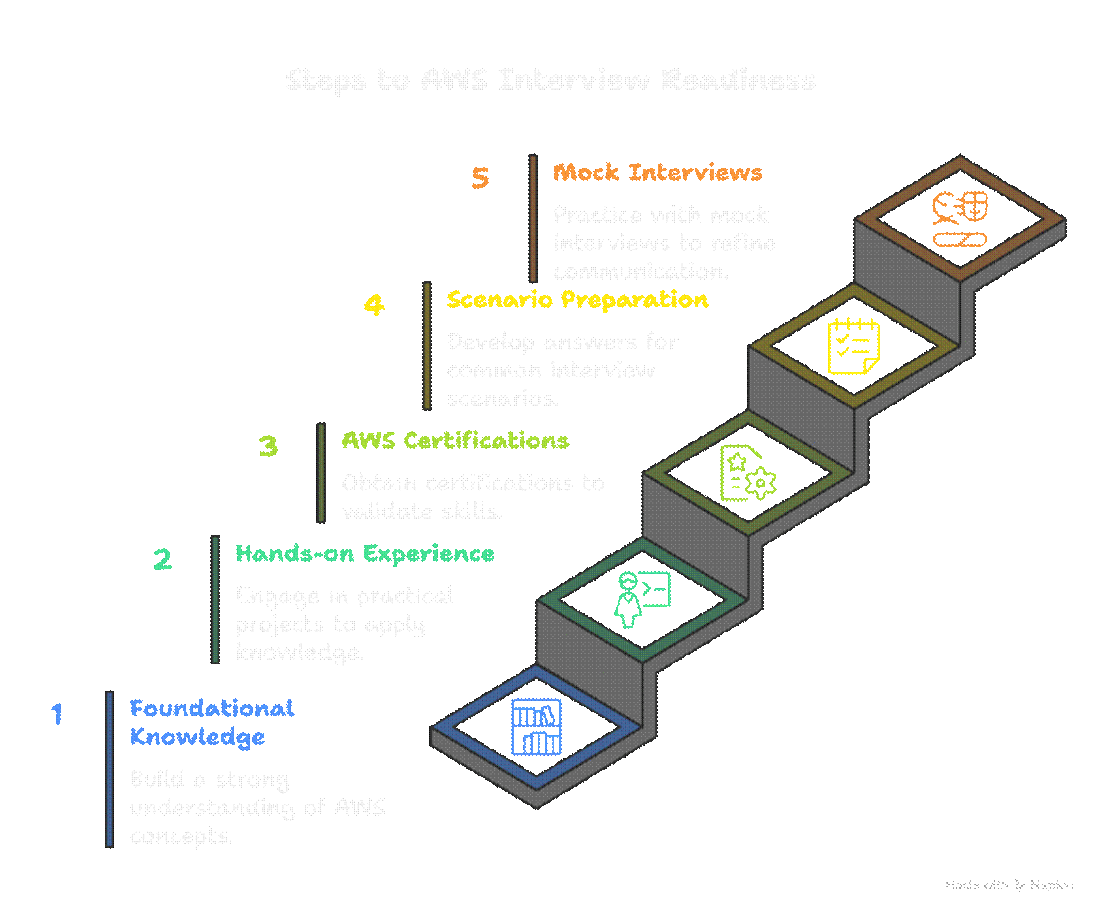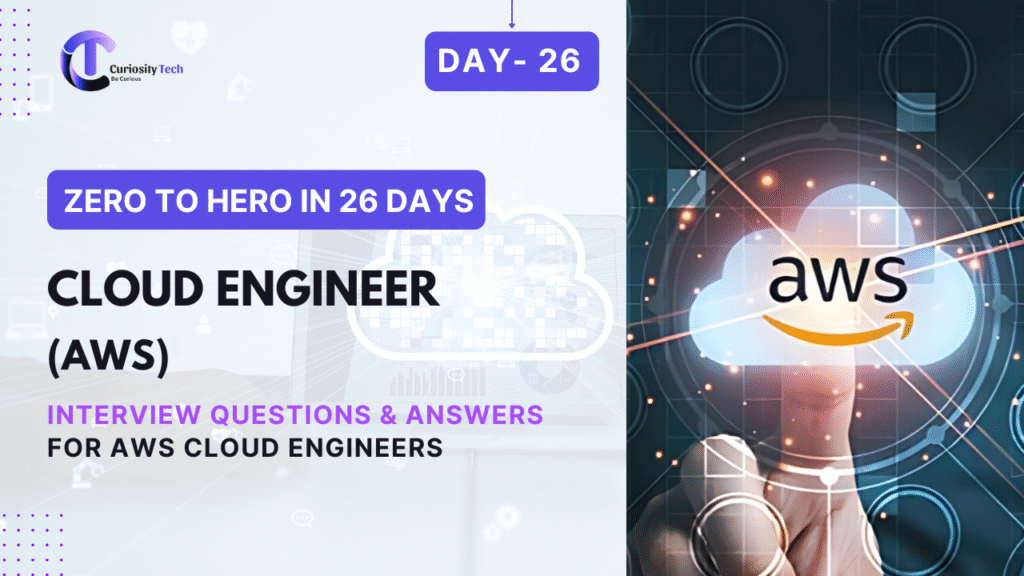On Day 26, we focus on preparing for AWS Cloud Engineer interviews, covering most commonly asked questions, scenario-based answers, preparation tips, and best practices.
At CuriosityTech.in, learners understand that interview success requires not only knowledge but also the ability to explain solutions clearly, handle scenarios, and demonstrate hands-on expertise.
1. Core Interview Preparation Strategy
- Understand AWS Services: EC2, S3, RDS, Lambda, VPC, CloudFormation, IAM, Route 53, CloudWatch
- Hands-on Practice: Demonstrate working experience, not just theoretical knowledge
- Scenario-Based Problem Solving: Explain architecture decisions, trade-offs, and solutions
- Soft Skills: Communication, collaboration, and problem-solving
- Certification Leverage: Use certifications to validate knowledge but supplement with projects
CuriosityTech.in Insight: Learners who combine theoretical understanding, certifications, and lab projects are best positioned to succeed in AWS interviews.
2. Common Interview Questions and Detailed Answers
Q1 – What is AWS and why is it used?
Answer:
AWS (Amazon Web Services) is a comprehensive cloud platform offering infrastructure, storage, databases, analytics, machine learning, networking, and security services.
It is used to:
- Reduce infrastructure costs by using on-demand resources
- Scale applications globally with auto-scaling and multi-region deployments
- Improve reliability with highly available services and managed solutions
Q2 – Explain IAM and its importance
Answer:
IAM (Identity & Access Management) is a service for securely controlling access to AWS resources.
Key aspects:
- Users, Groups, Roles, Policies
- Fine-grained permissions to follow the principle of least privilege
- Integration with CloudTrail for auditing
Importance: Ensures security and compliance, preventing unauthorized access.
Scenario Tip: When asked, give a real-world example: “We used IAM roles for EC2 instances to securely access S3 buckets without embedding credentials in code.”
Q3 – What is the difference between EC2 and Lambda?
Answer:
| Feature | EC2 | Lambda |
| Compute Type | VM instances | Serverless functions |
| Management | You manage OS & scaling | Fully managed, auto-scaling |
| Billing | Per instance/hour | Per request and execution duration |
| Use Case | Long-running applications | Event-driven, on-demand tasks |
Scenario Tip: Discuss when to use Lambda (short-lived jobs) versus EC2 (persistent services).
Q4 – How do you secure data in AWS?
Answer:
Security best practices:
- Encrypt data at rest using KMS
- Encrypt data in transit using SSL/TLS
- Implement IAM policies and MFA
- Monitor with CloudTrail and Security Hub
- Use VPCs and security groups to control network access
Q5 – Explain S3 storage classes and use cases
Answer:
S3 storage classes:
- Standard: Frequently accessed data
- Intelligent-Tiering: Automatic cost optimization
- One Zone-IA: Infrequently accessed data in a single AZ
- Glacier / Glacier Deep Archive: Long-term archival
Scenario Tip: When asked, provide example: “We used S3 Glacier for backup logs that needed retention for 7 years.”
Q6 – What is CloudFormation and why is it used?
Answer:
CloudFormation is an Infrastructure as Code (IaC) service to automate deployment and management of AWS resources.
Benefits:
- Version-controlled templates
- Rapid, repeatable deployments
- Minimized manual errors
- Supports cross-service dependencies
Q7 – Explain multi-region deployment and failover strategy
Answer:
- Use Route 53 for DNS-based failover and latency routing
- Deploy EC2, RDS, and S3 across multiple regions
- Replicate data using RDS Global Databases or S3 Cross-Region Replication
- Monitor health with CloudWatch and automated alarms
Scenario Tip: Describe a real-world failover scenario and recovery time objective (RTO) considerations.
Q8 – How do you optimize AWS costs?
Answer:
Cost optimization strategies:
- Use Reserved Instances or Savings Plans for predictable workloads
- Employ Auto Scaling to match demand
- Choose right-sizing of instances based on monitoring metrics
- Use S3 lifecycle policies for storage cost reduction
- Continuously monitor with Cost Explorer and Trusted Advisor
Q9 – How do you monitor AWS resources?
Answer:
- CloudWatch: Metrics, alarms, and dashboards
- CloudTrail: Track API calls for auditing
- AWS Config: Monitor configuration compliance
- Trusted Advisor: Best practices and cost optimization suggestions
Q10 – Scenario-Based Question
Question: Design a highly available web application on AWS.
Answer:
- Deploy EC2 instances across multiple AZs
- Use Elastic Load Balancer for traffic distribution
- Store static assets in S3 with CloudFront CDN
- Use RDS Multi-AZ for database redundancy
- Enable CloudWatch monitoring and alarms for uptime
- Consider Route 53 for DNS failover
CuriosityTech.in Insight: Practical examples like this help demonstrate both technical understanding and architectural thinking, which interviewers highly value.
3. Common Mistakes in AWS Interviews
- Memorizing answers without understanding concepts
- Ignoring hands-on labs → lack of practical experience
- Overlooking security and cost optimization topics
- Providing incomplete scenario answers
- Failing to articulate trade-offs and design reasoning
CuriosityTech.in Tip: Always relate answers to real-world projects or labs, showing both theoretical knowledge and practical implementation.
4. Recommended Preparation Approach
- Review core AWS services and documentation
- Perform hands-on labs for EC2, S3, Lambda, IAM, CloudFormation
- Solve scenario-based exercises for architecture and troubleshooting
- Take practice exams to identify weak areas
- Join study groups or mentorship programs, e.g., CuriosityTech.in labs
5. Path to Interview Readiness

At CuriosityTech.in, learners are trained to combine theoretical understanding, practical skills, and communication strategies, ensuring they are fully prepared for AWS cloud interviews.
6. Conclusion
AWS Cloud Engineer interviews assess both technical proficiency and practical problem-solving abilities.
By mastering core services, security, cost management, monitoring, architecture best practices, and scenario-based problem solving, learners gain the confidence to excel in AWS interviews.
CuriosityTech.in provides hands-on labs, scenario simulations, and expert guidance, making learners interview-ready and industry-competitive.



